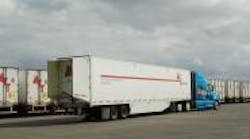“Of course, it comes down to getting our drivers to drive the truck right to achieve … fuel savings.” –Mesilla Valley Transportation executive vice president Jimmy Ray
It’s a maxim that I’ve heard over and over in recent weeks when the subject turned to the topic of improving the fuel economy of trucks: without a good driver behind the wheel, operating the vehicle in the most fuel-efficient manner, all sorts of technological advances can be for naught in the end.
Jimmy Ray, executive vp with Mesilla Valley Transportation, pointed this out yesterday during a press event held at the 2011 Technology & Maintenance Council’s annual meeting (held this year in Tampa, FL). In fact, his company goes so far as to award a brand new Harley Davidson motorcycle EVERY QUARTER to the drivers that achieve the best fuel economy.
Don’t think that achieves results? Well, Ray told me that the drivers who end up winning this quarterly contest are getting OVER 10 miles per gallon with their rigs – with some exceeding 11 mpg. And the money the fleet save from the fuel-sipping habits of its drivers more than pay for a few Harley’s every year.
Across the pond, Leif Östling, president and CEO of truck maker Scania made the exact same point regarding the importance of drivers in the fuel economy – and environmental impact – equation.
“Driver training is the fastest, easiest way to reduce fuel consumption and thus carbon dioxide emissions. As much as a 20% reduction [in fuel consumption] is within reach,” he explained to participants at the Scania transport conference held in Brussels, Belgium late last month.
“We can achieve very quick gains in this area; the savings potential is well documented,” Östling (at right) noted.
To assess vehicle performance in actual transport assignments, Scania maintains a small fleet of 20 trucks that it uses to distribute components between its various production units in Europe.
“Even though all the drivers are equally well trained and have access to the same support systems, we can clearly see differences between drivers that can’t be explained,” Östling pointed out. “Some use 4% to 5% less fuel than others. With no training at all, that difference could be 20%.”
[Here’s a technology package the company developed called Scania driver support that specifically tried to help spread such “best driver practices” to anyone behind the wheel of one of its big rigs in Europe.]
Combining several measures, Scania demonstrated in several tests that fuel consumption can drop below 20 litres per 100 kilometres (roughly 5.28 gallons per 62.13 miles) for a 34-tonne truck and trailer combination (which equates to about 74,957 pounds). That corresponds to fuel consumption by four passenger cars, Scania noted.
“We simply cannot wait for future technology; there is plenty we can accomplish here and now,” added Lars Stenqvist, senior vp-vehicle definition for Scania. “There are many viable solutions that can influence the bulk of transport. But they require a long-term mindset change.”
That “mindset” includes making the driver a far more integrated piece of the fuel economy solution. Indeed, that proved to be the solution for a problem Sysco Foods discovered when it started adding diesel-electric hybrid Class 7 tractors to its fleet in Texas several years ago.
In talking with some of the company’s fleet personnel at the Maryland Hybrid truck Initiative (MHTI) kickoff event last month, they were perplexed when data came back showing the diesel-electric hybrids – supposed to deliver some 20% to 30% better fuel economy – showed almost no difference whatsoever in fuel efficiency when compared to the fleet’s diesel-only trucks.
Yet, after digging a little deeper, they found the WAY the hybrids were being driven – with fast “jack-rabbit” acceleration a major factor – totally negated any advantage the technology was supposed to deliver in terms of fuel savings.
Yet after spending a few days talking with their drivers, telling them how to drive the vehicle to maximize “re-capturing” braking energy so it could be “re-used” during acceleration, Sysco found that almost overnight they were achieving the expected fuel savings.
“All we had to do was tell our drivers what to do and they went out and made it happen,” one of the Sysco fleet managers told me.
Proof positive again that without good drivers, good things – like saving fuel – are hard to achieve in trucking.





